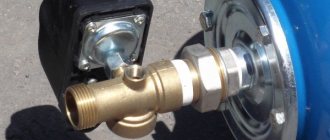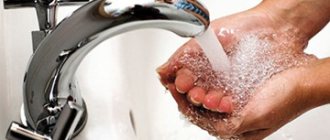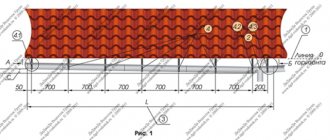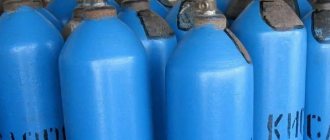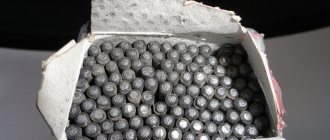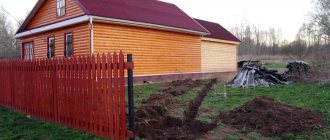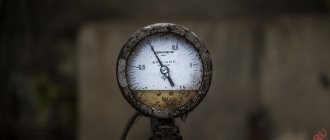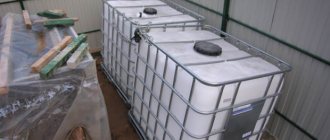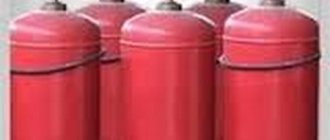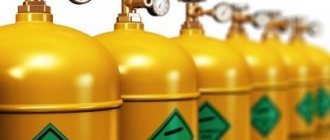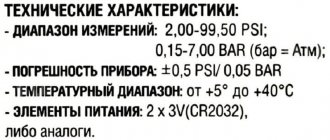OKP 14 1200
By Decree of the State Committee of Standards of the Council of Ministers of the USSR of December 19, 1973 N 2717, the introduction date was set from 01/01/75.
By Decree of the USSR State Standard dated August 14, 1991 N 1352, the validity period was lifted.
This standard applies to cylinders made of carbon and alloy steel, small volume - up to 12 liters and medium volume - from 20 to 50 liters with a working pressure of up to 19.6 MPa (200 kgf/cm2), made of seamless pipes and intended for storage and transportation of compressed, liquefied and dissolved gases at temperatures from minus 50 to plus 60°C.
The standard complies with the CMEA standardization recommendation PC 2496-70.
High temperature lamps
- There are devices where MAPP gas is used instead of a propane-butane mixture. The flame temperature in these devices is 2200−2400°C. The main energy is concentrated in a cone, which is quite stable and has a pronounced boundary.
- Such products are used for heating, bending and forging massive parts and high-carbon steels. High temperature allows for better tempering and hardening of metal.
- As for welding and soldering, MAPP gas devices do an excellent job with stainless steel, and even thin parts do not overheat. Another advantage of MAPP is its low boiling point, which allows it to be used at temperatures of -20°C even in products without a heating circuit.
Read also: Do-it-yourself powerful grain crusher
MAIN PARAMETERS AND DIMENSIONS
1.1. Cylinders must be manufactured for a working pressure of 9.8; 14.7; 19.6 MPa (100, 150 and 200 kgf/cm2) from carbon steel and for working pressure 14.7 and 19.6 MPa (150 and 200 kgf/cm2) from alloy steel.
1.2. The main parameters and dimensions of the cylinders must correspond to those indicated in the drawing and table. 1.
Official publication Reissue (June 1992) with Changes N∙ ], 2. 3, 4, approved in October 1976, October 1980, February 1982, June 1986 (IUS 11-76.1-81, S-82.10-86).
© Standards Publishing House, 1974
© Standards Publishing House, 1992
Rice. 1 1 — support shoe; 2 — cylinder body; 3 — neck ring; 4 - valve; 5 - safety cap.
Dimensions in mm
Table 1
| Cylinder volume, l | Diameter of cylindrical part | Wall thickness of pressure cylinders, MPa (kgf/cm2), not less | Pressure cylinder body length, MPa (kgf/cm2) | Mass of cylinders for pressure MPa (kgf/cm2), kg | ||||||||||||
| carbon steel | alloy steel | carbon steel | alloy steel | carbon steel | alloy steel | |||||||||||
| 9.8 (100) | 14.7 (150) | 19.6 (200) | 14,7 (150) | 19.6 (200) | 9.8 (100) | 14.7 (150) | 19,6 (200) | 14,7 (150) | 19,6 (200) | 9,8 (100) | 14,7 (150) | 19.6 (200) | 14,7 (150) | 19.6 (200) | ||
| 0,4 | 70 | 1,6 | 2,2 | 2,9 | 1,0 | 1,9 | 165 | 170 | 175 | 165 | 165 | 0,6 | 0,8 | 1,0 | 0.6 | 0,7 |
| 0,7 | 255 | 260 | 270 | 255 | 255 | 0,9 | 1,2 | 1,5 | 0,9 | 1,0 | ||||||
| 1,0 | ,89 | 1,9 | 2,8 | 3,6 | 1,9 | 2,5 | 240 | 250 | 255 | 240 | 245 | 1,2 | 1,8 | 23 | 1.2 | 1,6 |
| 1,3 | 295 | 305 | 315 | 295 | 300 | 1,5 | 2,2 | 2,? | 1.5 | 1,9 | ||||||
| 2,0 | 425 | 440 | 455 | 425 | 435 | 2,1 | 3,1 | 4,0 | 2,1 | 2,7 | ||||||
| 2,0 | 108 | 2,4 | 3,4 | 4,4, | 2,4 | 3,0 | 320 | 330 | 340 | 320 | 325 | 2,5 | 3,7 | 4.7 | 2,5 | 3,1 |
| 3,0 | 445 | 460 | 480 | 445 | 455 | 3,4 | 5,0 | 6.4 | 3,4 | 4,3 | ||||||
| 3,0 | 140 | 3,1 | 4,4 | 5,7 | 3,1 | 3,9 | 310 | 325 | 335 | 310 | 320 | 4,1 | 6,0 | 7,9 | 4,1 | 5,3 |
| 4,0 | 385 | 400 | 415 | 385 | 395 | 5,0 | 7,3 | 9,6 | 5,0 | 6,5 | ||||||
| 5,0 | 460 | 475 | 495 | 460 | 470 | 5,8 | 8,5 | 11,4 | 5,8 | 7,6 | ||||||
| 6,0 | 535 | 555 | 575 | 535 | 550 | 6,7 | 9.8 | 13,1 | 6,7 | 8,8 | ||||||
| 7,0 | 610 | 630 | 660 | 610 | 625 | 7,6 | 11,1 | 14,9 | 7,6 | 9,9 | ||||||
| 8,0 | 140 | 3,1 | 4,4 | 5,7 | 3,1 | 3,9 | 680 | 710 | 740 | 680 | 700 | 8,5 | 12,4 | 16,6 | 8,5 | 11,1 |
| 10,0 | 830 | 865 | 900 | 830 | 850 | 10,2 | 15,0 | 20,1 | 10,2 | 13,4 | ||||||
| 12,0 | 975 | 1020 | 1060 | 975 | 1005 | 1,9 | 17,6 | 23,5 | 11,9 | 15,6 | ||||||
| 20,0 | 219 | 5,2 | 6,8 | 8,9 | 5,2 | 6,0 | 730 | 740 | 770 | 730 | 28,5 | 33,3 | 42,0 | 28,5 | ||
| 25,0 | 890 | 900 | 935 | 890 | 34,0 | 38.7 | 50,5 | 34,0 | ||||||||
| 32,0 | 1105 | 1120 | 1165 | 1105 | 42.0 | 47,7 | 62,5 | 42,0 | ||||||||
| 40,0 | 1350 | 1370 | 1430 | 1350 | 5i,5 | 58,5 | 76,5 | 51,5 | ||||||||
| 50,0 | 1660 | 1685 | 1755 | 1660 | 62.5 | 71,3 | 93,0 | 62,5 | ||||||||
Notes:
- 1. The weight of cylinders is indicated without valves, caps, rings and shoes and is a reference value and a nominal value for the manufacture of cylinders with a weight limit.
- 2. The lengths of the cylinders are indicated as reference and are accepted as nominal when manufacturing cylinders with a limited length.
- 3. The approximate weight of the metal cap is 1.8 kg; from fiberglass - 0.5 kg; rings - 0.3 kg, shoes - 5.2 kg.
1.1; 1.2. (Changed edition, Rev. N4).
1.3. Cylinders must be manufactured with normal and increased precision.
1.4.
Conventional precision cylinders are manufactured with a limited volume; cylinders of increased precision - by volume and outer diameter or by length and outer diameter. Maximum deviations should not exceed those indicated in the table. 2. Table 2
| Limit deviations | For standard precision cylinders | For high precision cylinders |
| By volume: | ||
| for small volume cylinders | +10% ‘ | . +5% |
| for medium volume cylinders | + 5% | +5% |
| By lenght: | ||
| for small volume cylinders | — | ?6 mm |
| for medium volume cylinders | — | ?15 mm |
| By outer diameter: | ||
| for carbon steel cylinders | — | ?1,5% |
| for alloy steel cylinders | — | ?2,0% |
Notes:
- 1. Maximum deviations in outer diameter for medium-volume cylinders made of carbon steel, which have been assigned the State Quality Mark, must not exceed ? 1.0%.
- 2. The curvature of medium-volume cylinders is no more than 0.5% of the length of the cylindrical part of the cylinder.
(Changed edition, Amendment No. 1, 3).
1.5. At the customer's request, alloy steel cylinders can be manufactured with weight restrictions. In this case, the mass of the cylinders should not exceed by more than 10% the mass indicated in the table. 1. Examples of symbols:
cylinder with a volume of 4 liters for a pressure of 14.7 MPa (150 kgf/cm2), made of carbon steel, standard manufacturing precision, for air:
- Air cylinder 4-150U GOST 949-73
the same, from alloy steel, increased manufacturing precision, with volume limitation, without weight limitation, for nitrogen:
- Nitrogen cylinder 4p-150L GOST 949-73
the same, with normal manufacturing precision, with mass restrictions, for air:
- Air cylinder 4-150 L-M GOST 949-73
the same, with increased manufacturing accuracy in terms of volume, with mass restrictions, for medical oxygen:
- Cylinder for medical oxygen 4P-150L-M GOST 949-73
the same, increased manufacturing precision, cylinder body length 400 mm, with weight limitation, for nitrogen:
- Nitrogen cylinder 4-150L-400-M GOST 949-73
the same, short volume 2 liters for a pressure of 14.7 MPa (150 kgf/cm2), made of carbon steel, increased manufacturing precision with a length limitation, without a weight limitation, for air:
- Cylinder for. air K2-150U-330 GOST 949-78 (Changed edition, Amendment No. 4).
TECHNICAL REQUIREMENTS
2.1. Cylinders must be manufactured in accordance with the requirements of this standard and the “Rules for the design and safe operation of pressure vessels” approved by the USSR State Technical Supervision Authority according to working drawings approved in the prescribed manner. (Changed edition, Amendment No. 4).
2.la. Cylinders must be made from pipes that have undergone ultrasonic testing of metal continuity.
Note. The requirement of clause 2.1a is introduced from 01/01/89. (Introduced additionally, Amendment No. 4).
2.2.
The mechanical properties of the cylinder material must correspond to those indicated in the table. 3. Table 3
| Name of properties | Carbon steel | Alloy steel |
| Temporary resistance 6V, N/mm2 (kgf/mm2), not less | 638 (65) | 883 (90) |
| Yield strength Ov, N/mm2 (kgf/mm2), not less | 373 (38) | 687 (70) |
| Relative elongation bz, °/о, not less | 1.5 | 10 |
| Impact strength KCU, J/cm2 (kgf-m/cm2), not less, at 20°C | 29,4 (3) | 98,1 (10) |
(Changed edition, Amendment No. 4).
2.3. The materials of the cylinder valve bodies depending on the gas being filled, as well as the direction of the thread of the side fitting are indicated in the appendix. The side fittings of valves for toxic and flammable gases must be equipped with plugs. (Changed edition, Amendment No. 1, 4).
2.4. The outer and inner surfaces of the cylinders must be free of caps, holes, dulls, and cracks. Depressions, marks, traces of scale or tools, compacted and open wrinkles on the inner surface of the necks and bottoms and other minor defects should not be removed. wall thickness for the smallest values indicated in the table. 1. (Changed edition, Amendment No. 1).
2.5. The thread of the neck of the cylinders must be made in accordance with GOST 9909-81, in this case:
- the outer diameter of the thread in the plane of the end should be: for small volume cylinders - 19.2 mm, . for medium-volume cylinders - 27.8 mm,
- for medium volume cylinders (acetylene) - 30.3 mm;
2.6. At the request of consumers, cylinders can be manufactured with agreed dimensions of the outer diameter of the neck.
2.7. A steel ring must be securely fastened to the neck of cylinders with safety caps.
2.8. Rings and safety caps must be interchangeable.
2.9. In the threads of rings and caps, local minor tears and gouges with a length of no more than one third of the circumference are allowed on no more than one third of the total number of threads.
2.10. Shoes made from a section of steel pipe. must be tightly fitted onto the cylinders with a gap between the supporting plane of the shoe and the bottom of the cylinder of at least 10 mm.
2.11.
Valves of cylinders intended for liquid chlorine. must be equipped with a steel siphon tube, the length of which must correspond to that indicated in the table. 4. ' Table 4
| Cylinder volume, l | 20 | 25 | 32 | 40 | 50 |
| Tube length, mm, no more | 675 | 825 | 1045 | 1275 | 1575 |
2.12. Before screwing in valves or installing plugs in the necks, the inner surface of the cylinders must be cleaned of chips and loose scale. A thin remaining layer of oxides obtained during normalization, as well as individual stains caused by the method of cleaning the cylinders, are allowed. Small volume cylinders intended for medical oxygen, as well as on special orders from consumers, must be completely free of scale.
2.13. Cylinders for oxygen or hydrogen must be degreased, and those without valves must be additionally degreased at the customer’s site. Water and dirt are not allowed in the cylinders. .(Changed edition, Amendment No. 2).
2.14. Cylinders must be painted on the outside with oil, enamel or nitro paint. The marks must be clearly visible after painting. At the customer's request, the cylinders may not be painted.
2.15. Cylinders must be equipped with the following parts:
- a) small-volume cylinders with valves, and upon customer’s request, without valves;
- b) medium volume cylinders for acetylene - rings, caps and shoes;
- c) medium volume cylinders for ammonia, chlorine, phosphene, pseudobutylene, sulfur dioxide - valves, rings and caps;
- d) medium-volume cylinders, with the exception of cylinders specified in subparagraphs b and c, with valves, rings, caps and shoes.
It is allowed to complete cylinders with separate parts upon customer request.
ACCEPTANCE RULES
3.1. Each cylinder must be subjected to smoke acceptance tests.
3.2. Cylinders are accepted in batches of up to 400 pcs. the same volume, size and the same heat treatment regime.
3.3. Acceptance tests include:
- test of endurance;
- leak test;
- tensile test;
- impact bending test;
- visual inspection;
- determination of mass;
- determination of volume.
3.4. The tensile test should be carried out on short longitudinal specimens. Samples in their calculation part should not be straightened.
3.5. The impact test shall be carried out on longitudinal specimens of type V. The axis of the notch shall be perpendicular to the wide edges of the specimen. Cylinders with a wall thickness of at least 5 mm are tested.
3.6. For tensile and impact bending tests, samples are cut from the bodies of finished cylinders or witness pipes, cut from the pipes from which a given batch of cylinders is made, and heat treated together with the cylinders of a given batch, and from alloy steel also from the same heat. For each test, at least two samples are taken from the lot. (Changed edition, Amendment No. 4).
3.7. If the test results do not comply with the requirements of this standard, tests are carried out on twice the number of samples. The results of the spot check apply to the entire lot. (Changed edition, Amendment No. 3).
3.8. Acetylene cylinders must be tested for leaks at factories that fill the cylinders with porous mass. (Introduced additionally, Amendment No. 3).
Video description
Video about what household gas cylinders are:
Connection
All issues related to resource consumption, for example, how much gas is in a 50 liter cylinder (m3), must be resolved in advance - before connecting. Since the procedure for connecting to the equipment is extremely important from the point of view of subsequent safety during operation, the following series of requirements are taken into account during installation:
- Threaded connections and other joints must be protected from the slightest leaks to avoid the formation of explosive gas-air mixtures.
- If the cylinder is located inside a heated room, its overheating is unacceptable in order to avoid an increase in internal pressure above the permissible norm.
- Transporting containers to the installation site must avoid impact and friction on their body.
- Elements connecting to the equipment (hoses, adapters, gearboxes) must not be damaged, cracked, dirty, or rusty.
4. TEST METHODS
4.1. Pneumatic and hydraulic pressure tests are carried out in accordance with the “Rules for the design and safe operation of pressure vessels.” Test duration is at least 1 minute. Pneumatic tests of cylinders intended for filling with gases, the penetrating ability of which is higher than that of air, must be carried out in accordance with regulatory and technical documentation. (Changed edition, Amendment No. 4).
4.2; 4.3. (Excluded, Amendment No. 4).
4.4. Cylinders equipped with a chlorine valve are tested with a pneumatic pressure equal to 2.94 (30 kgf/cm2).
4.5. Tensile test according to GOST 10006-80. The test speed up to the yield point and during its passage is no more than 10 mm/min, beyond the yield point is no more than 40 mm/min. It is allowed to control the mechanical properties of carbon steel cylinders using a non-destructive method according to the regulatory and technical documentation. In controversial cases, tests are carried out in accordance with GOST 10006-80.
4.6. Impact bending test - according to GOST 9454-78 on longitudinal samples of type 3.
4.7. If the test results do not comply with the requirements of this standard, tests are carried out on twice the number of samples. If the results of repeated tests are unsatisfactory, the entire batch of cylinders is sent a second time for heat treatment. No more than two repeated heat treatments are allowed. Additional tempering is not considered repeated heat treatment. (Changed edition, Amendment No. 4).
4.8. The volume of the cylinder must be controlled by limiting templates along the length; in this case, the volume of the cylinder should not be lower than the nominal one. The volume of two cylinders from a batch is checked by filling with water and determining the volume or mass of water.
Note. From 01/01/89, determination of the volume of all medium-volume cylinders is introduced. (Changed edition, Amendment No. 1, 2).
Connecting gas cylinders
Most gas cylinders are used to operate kitchen stoves. They must be connected to consumer devices through a reducer. The gas pressure in the cylinder is constantly changing - it depends on the ambient temperature. It is in the range of 4-6 atmospheres. When using a reducer, it is possible to increase or decrease the pressure to the optimal value of the stove.
First, a hose is connected to the reducer, and then a plate is connected to it. The place where the connection will be made is secured with clamps. Then be sure to check the tightness of the fixation with soap foam. If bubbles form, the connection can be considered leaking.
The leak is eliminated by further tightening the nut at the place where the fitting and gearbox are fixed. If a leak is detected in the hose area, tighten the clamps. Once the adjustment is complete, perform another soap suds test to make sure there is no leakage. This check is always carried out when a gas cylinder is connected.
As you can see, propane cylinders are in great demand in various industries. Before choosing certain products, it is worth understanding their characteristics and operating features.
LABELING, PACKAGING, TRANSPORTATION AND STORAGE
5.1. Cylinders are marked in accordance with the requirements of the “Rules for the Design and Safe Operation of Pressure Vessels”. Additionally, data on the type of heat treatment is applied:
- N - normalization;
- V - hardening and tempering.
Note. Until 01/01/89, the nominal volume of the cylinder is indicated.
5.2. The inscriptions on the cylinders and their painting are carried out in accordance with the “Rules for the design and safe operation of pressure vessels” and Table. 5.
5.3. Cylinders transported without valves must be protected from contamination with polyethylene or nylon plugs.
5.4.
Small volume cylinders are transported in containers made according to GOST 18477-79, without packaging. When shipped by carload in covered wagons, small-volume cylinders are transported packed in boxes in accordance with GOST 2991-85 (type III-1) with a cargo weight of no more than 200 kg or stacked up to the full capacity of the wagon. Dimensions of boxes according to regulatory and technical documentation in accordance with the requirements of GOST 21140-88; Medium-volume cylinders are transported without packaging. covered cars, gondola cars or containers manufactured in accordance with GOST 18477-79. It is allowed to transport cylinders in multi-turn packaging means in gondola cars or in packages in special cars. Table 5
| Name of gas | Coloring of cylinders | Inscription text | Lettering color | Stripe color |
| Nitrogen | Black | Nitrogen | Yellow | Brown |
| Ammonia | Yellow | Ammonia | Black | — |
| Argon raw | Black | Argon raw | White | White |
| Argon technical | Black | Argon technical | Blue | Blue |
| Argon pure | Gray | Argon pure | Green | Green |
| Acetylene | White | Acetylene | Red | — |
| Butane | Red | Butane | White | — |
| Butylene | Red | Butylene | Yellow | Black |
| Hydrogen | Dark green | Hydrogen | Red | — |
| Air | Black | Compressed air | White | — |
| Helium | Brown | Helium | White | — |
| Nitrous oxide | Gray | Nitrous oxide | Black | — |
| Oxygen | Blue | Oxygen | Black | -=- |
| Medical oxygen | Blue | Medical oxygen | Black | — |
| Oil and Gas | Gray | Oil and Gas | Red | — |
| Hydrogen sulfide | White | Hydrogen sulfide | Red | Red |
| Sulfur dioxide | Black | Sulfur dioxide | White | Yellow |
| Carbon dioxide | Black | Carbon dioxide | Yellow | — |
| Phosgene | Protective | — | — | Red |
| Freon | Aluminum or light gray | R (indicating its number) | Black | — |
| Chlorine | Protective | — | Green | |
| Cyclopropane | Orange | Cyclopropane | Black | — |
| Ethylene | Purple | Ethylene | Red | — |
| All other flammable gases | Red | Name of gas | White | — |
| All other non-flammable gases | Black | Name of gas | Yellow | — |
5.1; 5.2. (Changed edition, Amendment No. 4).
The arrangement and fastening of cylinders on vehicles must comply with the requirements of the “Technical conditions for loading and securing cargo” approved by the Ministry of Railways. (Changed edition, Amendment No. 4).
5.4a. Transport markings must be applied to one of the sides of each box, including main, additional and informational inscriptions in accordance with GOST 14192-77. (Introduced additionally, Amendment No. 4).
5.5. Cylinders are transported by all types of transport in accordance with the rules in force for each type.
5.6. Each batch of cylinders must be accompanied by a quality document certifying the cylinders’ compliance with the requirements of this standard, which must indicate:
- name of the manufacturer and its location (city or conventional address);
- product designation;
- number of cylinders and their numbers;
- results of hydraulic and pneumatic tests;
- designation of this standard.
5.5; 5.6. (Changed edition, Rev. N4).
5.7. Storage of cylinders according to group Zh2 GOST 15150-69.
5.8. Each cylinder that has been assigned the state Quality Mark in the prescribed manner and the certificate must be marked with an image of the state Quality Mark. in the manner established by Gosstandart. (Introduced additionally, Amendment No. 3).
Delivery across Russia
The order must be placed through the shopping cart on our website in the “Delivery method” section and select “Transport company, Russian Post”. After filling out all the data and selecting the delivery method, payment, a message with the order number will appear on the screen
In the last sentence of this text you will see “Download receipt” ATTENTION! You must click “Download receipt”, after which a receipt for payment will automatically be sent to your email. Method of payment for the order:
Payment method for order:
by bank receipt
Note! Payment is made without VAT (indicate “VAT not subject” in the purpose of payment) transfer in the Sberbank.Online system. by invoice for legal entities (without VAT!). Before payment, ALWAYS wait for confirmation of the order in the form of an email or a phone call from the manager
The receipt includes the cost of delivery by courier in Moscow to the transport company - 350 rubles. Payment for delivery services of the transport company itself is paid separately upon receipt of the goods
Before paying, you MUST wait for order confirmation in the form of an email or a phone call from the manager. The receipt includes the cost of delivery by courier in Moscow to the transport company - 350 rubles. Payment for delivery services to the transport company itself is paid separately upon receipt of the goods.
Attention! Delivery of peat dry toilets Piteco 505 and PIteco 905 throughout Russia is free! Details of the promotion can be found in the News section or by phone. And also for some types of goods, delivery within Moscow within the Moscow Ring Road is free of charge! This information can be clarified in the product card or by phone
(495)723-00-33
And also for some types of goods, delivery within Moscow within the Moscow Ring Road is free of charge! This information can be clarified in the product card or by phone.
| Transport company | Link |
| Business Line | https://www.dellin.ru/calculator/ |
| Auto trading | https://www.ae5000.ru/services/autorates/ |
| PEC | https://www.pecom.ru/ru/services/pricelist/calc.php |
| Post office | https://www.pochta.ru/parcels |
You can also calculate the approximate cost of delivery using TK calculators: *You can determine the volume of cargo using the following formula: D (m) x W (m) x H (m),
where G is the depth, W is the width, H is the height of the load in meters.
G= 320 cm; W=450 cm; H=540 cm.
then V = 0.32 m x 0.45 m x 0.54 m = 0.08 m 3
This means that the volume of our cargo will be 0.08 m3
Please note that this calculation is only an estimate. The exact delivery cost will be known only after the order is delivered to the transport company terminal
If none of the delivery methods suits you, you can always purchase the goods yourself in one of our stores.
If you have any questions, you can contact us by phone:
1
. metro station Rumyantsevo, BP Rumyantsevo, building G, entrance 7, floor 3, pavilion 329 (see below for directions). Store phone number: 89253326140
BP Rumyantsevo pickup point is OPEN!
on foot:
The business park is located right next to the Rumyantsevo metro station, from the metro go to the third building from the road, building G, entrance 7. pavilion 329. Welcome to our store!
by car:
Drive to the region along the Kievskoe highway, after about 500 m turn into the entrance to the Rumyantsevo business park (near the gas station). Next is building G, entrance number 7. Next to our building there is a parking lot, which store customers can use absolutely free for 1 hour.
2.
m. Semenovskaya, Trade and office center, st. Tkatskaya, 4, floor 2, store "Goods for home and garden"
From metro station Semenovskaya 5-7 minutes on foot. Coming out of the metro, turn right and walk 200 m along the street. Izmailovsky Val to st. Tkatskaya. Turn right and walk 250 m along the street. Tkatskaya to house No. 4. Go up to the 2nd floor and go to the door with the sign “Goods for the home and garden.” Welcome to our store!
If you have any questions, you can contact us by phone:
If you do not have the opportunity or time to pick up the goods yourself, you can order it for delivery. Read more about delivery of orders HERE
MANUFACTURER'S WARRANTY
6.1. The manufacturer must ensure that the cylinders comply with the requirements of this standard provided that the consumer complies with the operating, transportation and storage conditions established by this standard.
6.2. The warranty period is 2 years from the date of putting the cylinders into operation. For medium-volume carbon steel cylinders that have been awarded the State Quality Mark - 4 years from the date of commissioning. (Changed edition, Amendment No. 1). Sec. 7. (Deleted, Amendment No. 4).
CYLINDER VALVE CASE MATERIALS AND SIDE FITTING THREAD DIRECTION
Table 6
| Name of gases | Valve body material | Side fitting thread direction | Name of gases | Valve body material | Direction of Side Fitting |
| Nitrogen | Brass | Right | Methane | Brass | Left |
| Ammonia | Steel | Right | Propane and other flammable gases | Steel or brass | Left |
| Argon | Brass | Right | Sulfur dioxide | Steel | Right |
| Butane | Brass or steel | Left | Carbon dioxide | Brass | Right |
| Butylene | Brass | Left | Phosgene | Steel | Right |
| Hydrogen | Brass | Left | Freon | Steel or brass | Right |
| Air | Brass | Right | Chlorine | Steel | Right |
| Helium | Brass | Right | Chlormethyl-til | Brass | Left |
| Oxygen | Brass | Right | Chloroethyl | Brass | Left |
| Xenon | Brass | Right | Ethylene | Brass | Left |
Editor L. I. Nakhimova Technical editor O. N. Nikitina Proofreader V. I. Varentsova
Delivered to embankment 02.09.92 Sub. in the oven 16.10.92 Conditional p.l. 1.0. Conditional cr.-ott. 1.0. Uch.-ed. l. 0.83. Shooting gallery 1247 copies
Orders ■Badge of Honor■ Publishing house of standards, 123557, Moscow, GSP, Novopresnensky lane, 3 Type. ■Moscow printer■. Myskva, Lyalin lane, 6. Zak. 1462
Note. When ordering cylinders for gases not listed in the table, the customer must indicate the type of valve in the order.
